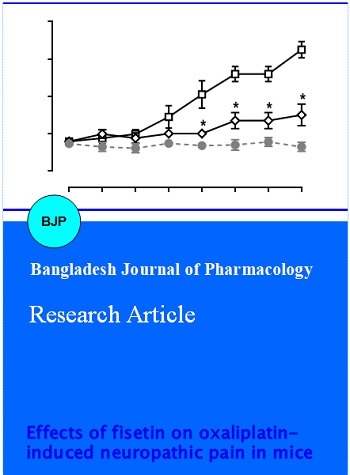Effects of fisetin on oxaliplatin-induced neuropathic pain in mice
DOI:
https://doi.org/10.3329/bjp.v10i1.21203Keywords:
Fisetin, Mice, Neuropathic pain, OxaliplatinAbstract
Common chemotherapeutic agents such as oxaliplatin often cause neuropathic pain during cancer treatment in patients. Such neuropathic pain is difficult to treat and responds poorly to common analgesics, which represents a challenging clinical issue. Fisetin is a naturally occurring flavonoid and this study tested the potential anti-hyperalgesic effects of fisetin in a mice model of oxaliplatin-induced neuropathic pain. Fisetin (1-4 mg/kg, i.p.) did not significantly alter the mechanical hypersensitivity in oxaliplatin-treated mice but produced a dose-dependent anti-hyperalgesic effect during repeated treatment. Repeated treatment with fisetin also prevented chronic neuropathic pain-induced depressive-like behavior in a forced swimming test. Both the antihyperalgesic and the antidepressant-like effects of fisetin can be blocked by a selective 5-HT1A receptor antagonist WAY100635 (1 mg/kg). Together, these results demonstrate that fisetin has significant analgesic efficacy against chronic neuropathic pain, which could be a useful analgesic in the management of neuropathic pain.
Downloads
398
263 Read
152

Published
How to Cite
Issue
Section
License
Authors who publish with this journal agree to the following terms:
- Authors retain copyright and grant the journal right of first publication with the work simultaneously licensed under a Creative Commons Attribution License that allows others to share the work with an acknowledgement of the work's authorship and initial publication in this journal.
- Authors are able to enter into separate, additional contractual arrangements for the non-exclusive distribution of the journal's published version of the work (e.g., post it to an institutional repository or publish it in a book), with an acknowledgement of its initial publication in this journal.
- Authors are permitted and encouraged to post their work online (e.g., in institutional repositories or on their website) prior to and during the submission process, as it can lead to productive exchanges, as well as earlier and greater citation of published work (See The Effect of Open Access).
